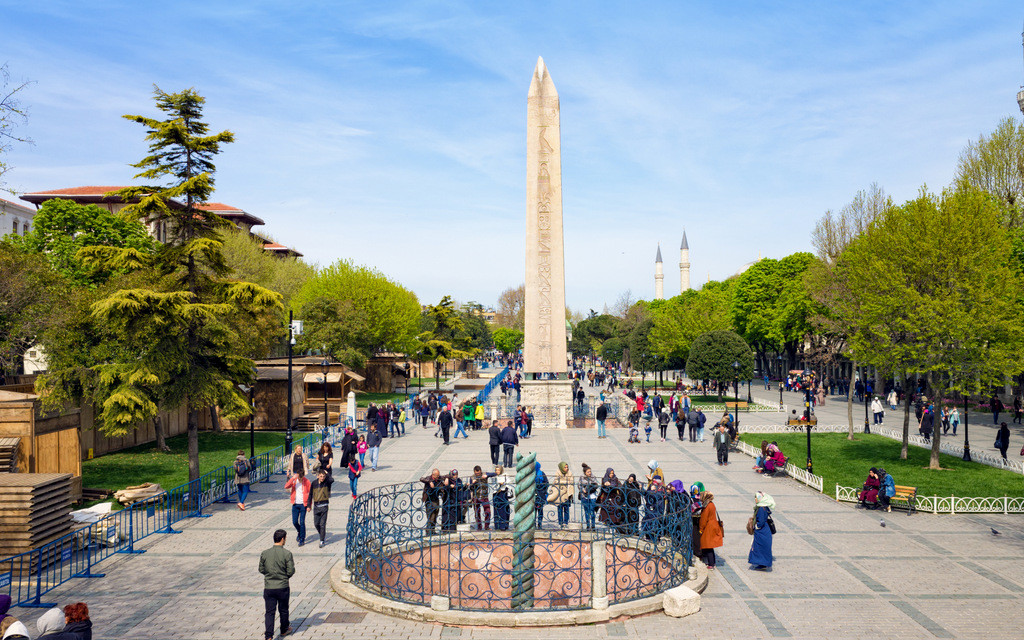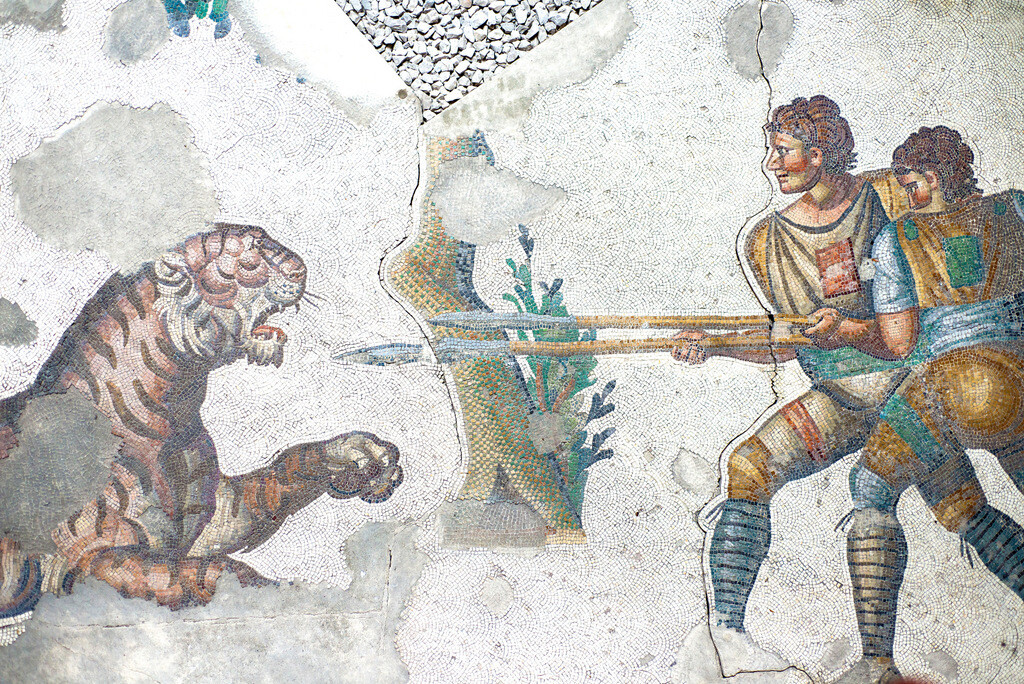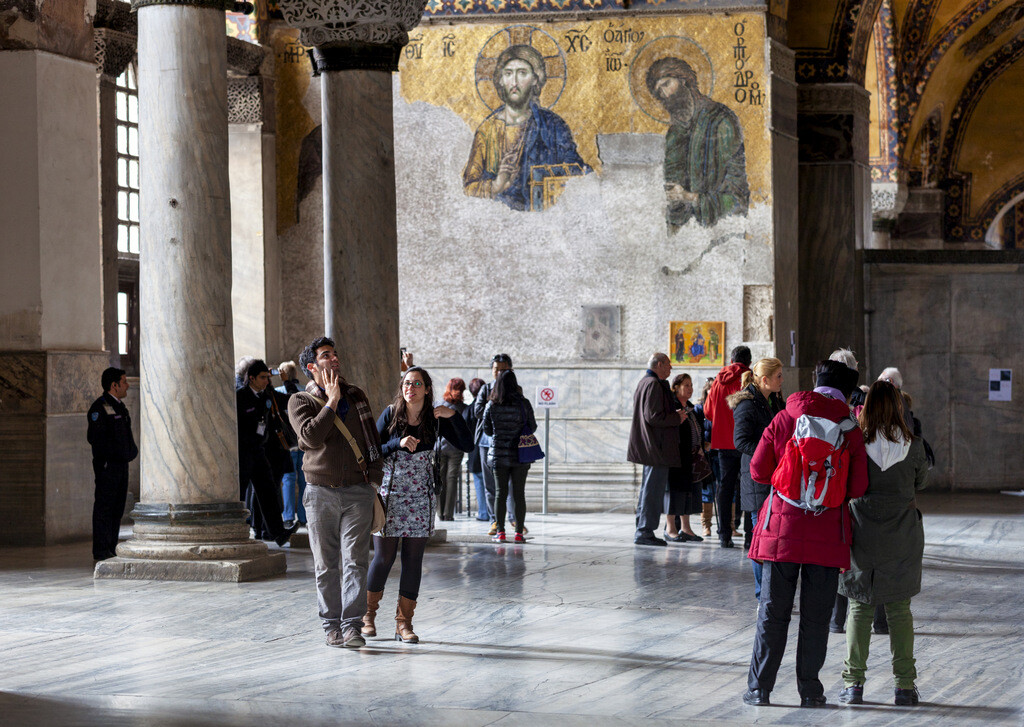There are still many Byzantine sites worth seeing in Istanbul. Most of these structures, built between the 4th and 15th centuries, are located in the Historical Peninsula (former Constantinople).
Currently, some of the Byzantine churches and palaces in Istanbul are being restored. When these are finished, I will add new ones to this list. I also try to keep the visitation status of the structures in the list as up-to-date as possible.
If you want to visit these structures with a local tour guide, you can contact me by filling out the form on the contact page. So I can send you the schedule of my current Byzantine tour in 2024.
1. Hippodrome
Hippodrome of Constantinople was one of the first buildings built in the city during the Roman period. During the reign of Constantine the Great, it had become a structure similar to the Circus Maximus in Rome.
Since the Hippodrome is home to the oldest historical monuments in Istanbul, I start my Byzantine Istanbul tour from here. Here is the perfect place to tell the history of Istanbul dating back to 600s BC.
The Hippodrome of Constantinople witnessed incredible events throughout the history of Byzantium. Many emperors were crowned or dethroned by the will of the people here. It is also worth noting that major uprisings such as the Nika Riots started from here.
2. Great Palace Mosaic Museum
Great Palace Mosaic Museum displays the only remnants of the Roman emperors’ magnificent palace in Constantinople. This palace was also built by Emperor Constantine at the same time as the previous Hippodrome.
The Great Palace was a huge complex of courtyards, pavilions, churches, and squares. The mosaics that once adorned one of the courtyards of the palace are exhibited in the Great Palace Mosaics Museum of Istanbul today.
3. Hagia Sophia
Hagia Sophia is the most important and magnificent historical monument that has survived from the Byzantine period. Hagia Sophia has existed for 1500 years and continues to inspire visitors from all over the world.
Hagia Sophia remained a church for 900 years in the Byzantine period and a mosque for 500 years in the Ottoman period. The structure is a must-see for those who want to see Byzantine sites in Istanbul.
Hagia Sophia remained a museum in the 20th century. However, as of 2020, it was turned back into a mosque again. The Byzantine mosaics in the upper floor galleries could not be seen for a while. However, starting from January 15, 2024, the upper floor of Hagia Sophia will be reopened to visitors.
4. Hagia Irene
Hagia Irene is an old Byzantine church located in the courtyard of Topkapi Palace today. This 8th-century building was built quite simply due to the influence of Byzantine iconoclasm.
Hagia Irene Church was essentially a contemporary building with Hagia Sophia and was built during the reign of Justinian. However, since the original structure was damaged in the earthquake, it was later rebuilt.
5. The Column of Goths
The Column of Goths is thought to be a victory monument erected in the 4th century when Rome fought the Ostrogoths. The Goths were the archenemy of Byzantium (Eastern Rome) for several centuries.
Today, Column of Goths is located in Gulhane Park, which is inside the great walls surrounding Topkapi Palace. This Roman column can be seen in the park’s interior, which overlooks the sea.
6. Basilica Cistern
Basilica Cistern is essentially a 1500-year-old water reservoir. However, there are such beautiful ancient columns and astonishing artifacts such as Medusa heads inside the building that Istanbulites call it the “Sunken Palace”.
Basilica Cistern was built during the reign of the famous Byzantine emperor Justinian, just like Hagia Sophia. When you go down to the cistern, which is quite below ground level, you will encounter a marvel of Roman architecture.
Basilica Cistern is an indispensable part of my Byzantine tour in Istanbul. I include the cistern in all my Byzantine history tours, whether it is a full day or a half day.
7. Theodosius Cistern
Theodosius Cistern is named after the emperor Theodosius II, who made great architectural contributions to Istanbul. The name of this emperor is also identified with the famous Walls of Constantinople (aka Theodosian Walls).
Theodosius Cistern is known locally as Serefiye Cistern and stands out as the oldest, though the smallest, of the three cisterns serving as a museum in Sultanahmet (the heart of the Old City).
8. Cistern of Philoxenos
Cistern of Philoxenos was a private venue that was opened in Istanbul only for exhibitions and special events. However, as of 2020, it has been opened to the public and can now be visited as a museum.
Cistern of Philoxenos is a special place that I frequently visit during my Byzantine Istanbul tour. Although not as popular as the Basilica Cistern, this is a great place to grasp the Byzantine history of Istanbul.
9. Church of Sergius and Bacchus
The Church of Sergius and Bacchus is known locally as Little Hagia Sophia, as it has a very similar history with its big brother, Hagia Sophia. Both structures were built by the famous emperor Justinian in the 6th century.
Church of Sergius and Bacchus is now known as Little Hagia Sophia Mosque. When there are very long queues in front of Hagia Sophia, I show my guests this 1500-year-old building as an alternative.
10. Bukoleon Palace
Bukoleon Palace was a building located on the south side of Constantinople, with a magnificent view of the waters of the Marmara Sea. It functioned as an extension of the Great Palace extending to the seashore.
Both the Great Palace and the Bukoleon Palace fell out of favor towards the end of the Byzantine era, as the emperors settled in the Palace of Blachernae, adjacent to the city walls.
Bukoleon Palace was a building that was on the verge of extinction until recently. However, with the initiative of the Istanbul Metropolitan Municipality, a major restoration was initiated in the palace in 2020.
11. The Forum of Constantine
The Forum of Constantine, along with the Great Palace and the Hippodrome, was among the first buildings of Constantinople. Emperor Constantine designed it as the main square of New Rome.
Today, Forum of Constantine is located near the Grand Bazaar and draws attention with its giant porphyry column. At the top of this column once stood an Apollo-like statue of Constantine the Great.
It is recommended to visit Byzantine sites such as the Forum of Constantine with a tourist guide in Istanbul. Because a knowledgeable local guide can make these structures that have lost their originality come alive in your eyes.
12. Valens Aqueduct
The Valens Aqueduct was once the most magnificent part of the massive Roman water system that carried water to Constantinople. The structure was dedicated to Emperor Valens, who died fighting the Goths in the 4th century.
Fresh drinking water carried from the mountains in the Balkans was transported to Istanbul by these giant Roman aqueducts and was stored in the cisterns mentioned above.
Today, Valens Aqueduct is known locally as the “Bozdogan Kemeri” and is a must-see for anyone who wants to see Byzantine buildings in Istanbul. There are also many churches from the late Byzantine period near the aqueduct.
13. Monastery of the Pantocrator
The Monastery of the Pantocrator was the third largest church in Constantinople. The building consisted of the joining of three separate churches and was the burial place of the late Byzantine emperors.
Only the church building remains of the Monastery of the Pantocrator, which was once a large complex. The building was converted into a mosque during the Ottoman period and became known as the Zeyrek Mosque.
One of the best places to examine Byzantine architecture in Istanbul is the Monastery of the Pantocrator. For this reason, you can add it to your list with the Valens Aqueduct, which is very close to it.
14. Pammakaristos Church
Pammakaristos Church was one of the small monasteries of the Byzantine period. However, its importance increased during the period when it was used as a patriarchate in the Ottoman period.
Although Pammakaristos Church was converted into a mosque in the 16th century and renamed Fethiye Mosque, there are still remains of Byzantine heritage inside. For this reason, a part of the building serves as Fethiye Museum.
The most important feature of Fethiye Museum is that it has the best preserved Byzantine mosaics in Istanbul, along with Hagia Sophia and Kariye Mosque. For this reason, it is an important place among the Byzantine sites in Istanbul.
15. Church of Saint Theodosia
Church of Saint Theodosia is one of the least known Byzantine churches in Istanbul. However, this building, known as Gul Mosque today, has a very impressive atmosphere.
According to tradition, Saint Theodosia was known as an iconodule martyred by the soldiers of the iconoclast emperor Leo III during the Byzantine Iconoclasm. Dating to the 11th century, this church was dedicated to her.
Some places in the Byzantine Istanbul tour intersect with Fener and Balat walking tour, which is another special tour I offer. If you want to learn about this tour, you can review the relevant article from here.
16. Church of Saint George
Church of Saint George has served as the main church of the Patriarchate of Constantinople for nearly 400 years. For this reason, many important relics from the Byzantine period are kept here.
The mysterious atmosphere and 1000-year-old relics in the Church of Saint George allow me to tell many stories about Byzantine history in Istanbul. For this reason, this is one of my favorite places on my Byzantine Istanbul tour.
17. Church of St Mary of the Mongols
Church of St Mary of the Mongols is known as the only Orthodox Church in Istanbul that has been serving uninterruptedly since the Byzantine period. For this reason, it has a special place in my tours.
I tell a few interesting stories associated with this church to my guests during the private Byzantine history tour in Istanbul. Just to satisfy your curiosity, this church was identified with a Byzantine princess named Maria Palaiologina, who was a bride to the Mongols.
18. Chora Church
Chora Church is a magnificent building that gives clues about the late period architecture of the Byzantine Empire. The best preserved Byzantine mosaics in Istanbul are inside this historical building.
Chora Church was converted into a mosque during the Ottoman Empire and was named the Kariye Mosque. The building, which was used as a museum for 90 years like Hagia Sophia, has now been converted into a mosque again.
Chora Church, or Kariye Mosque, as it is known today, is the second most important place after Hagia Sophia among the Byzantine sites in Istanbul. Because the Byzantine art here has no equal in the world.
Kariye Museum has been converted back into a mosque since 2020. Chora Church is still closed for restoration as of April 2024. You can find the most up-to-date information about the Chora Church, in this article here.
19. Palace of the Porphyrogenitus
The Palace of the Porphyrogenitus was an extension of the Palace of Blachernae, the main palace of the late Byzantine period. This annex is the only building that has survived from the original palace.
Palace of the Porphyrogenitus was known locally as the Tekfur Palace. The building was used as a tile workshop in Ottoman Istanbul for a period. Today, it serves as a museum.
The Great Palace and the Palace of Blachernae, which were the great Byzantine palaces in Istanbul, have completely disappeared and we have the Bukoleon and Porphyrogenitus palaces, which give an idea about them.
20. Walls of Constantinople
The Walls of Constantinople was built at the beginning of the 5th century, during the reign of Theodosius II, whose name is frequently mentioned in this article. These magnificent walls did not allow any hostile army to pass for 1000 years.
It was only in the 15th century that an enemy army broke through the Theodosian Walls and entered Constantinople, with the development of artillery and the creation of giant cannons.
Visiting the Byzantine walls in Istanbul has become easier with the work of the Istanbul Metropolitan Municipality in recent years. The walls are in very good condition with recent restorations and a travel map is also available from the tourist information offices.
For this reason, the Walls of Constantinople is one of the most important parts of Istanbul’s history. Therefore, it is one of the must-see places among Byzantine sites in Istanbul.
Conclusion
If you would like to explore Istanbul between the 4th and 15th centuries with me, you can contact me by filling out the form on the contact page. As a licensed tour guide based in Istanbul, I am ready to share with you what I know about the history of Byzantium.
There is information about my references on the about page of this site, but if you wish, you can also read reviews about me on TripAdvisor. Although some of these comments are about other tours, a significant part of them are feedback about my Byzantine Istanbul tour.
Written by Serhat Engul




Excellent !!! Pictures and information.
I love the history and architecture, I have been there in September 2019, but I couldn’t visit all these places.
Hello Janett, thank you for the feedback. Yes Istanbul is a big city and it should be visited several times. I hope you will be able to come back to see the rest of it. Cheers!
Very nice.
Hi Thomas, thank you for the feedback.
Very informative article! I wish I visited all this sites when I came to Constantinople. Next time for sure.
Hello Theo, it is a privilege for history buffs visiting Istanbul to know the Byzantine structures and to prepare an itinerary accordingly. Under another post, you noted that you have read many books on Byzantine history. I think you will enjoy it if you visit the Constantinople era buildings specifically for your next visit to Istanbul. It will probably take you 3 or 4 days to visit all sites related to Byzantine history in detail.